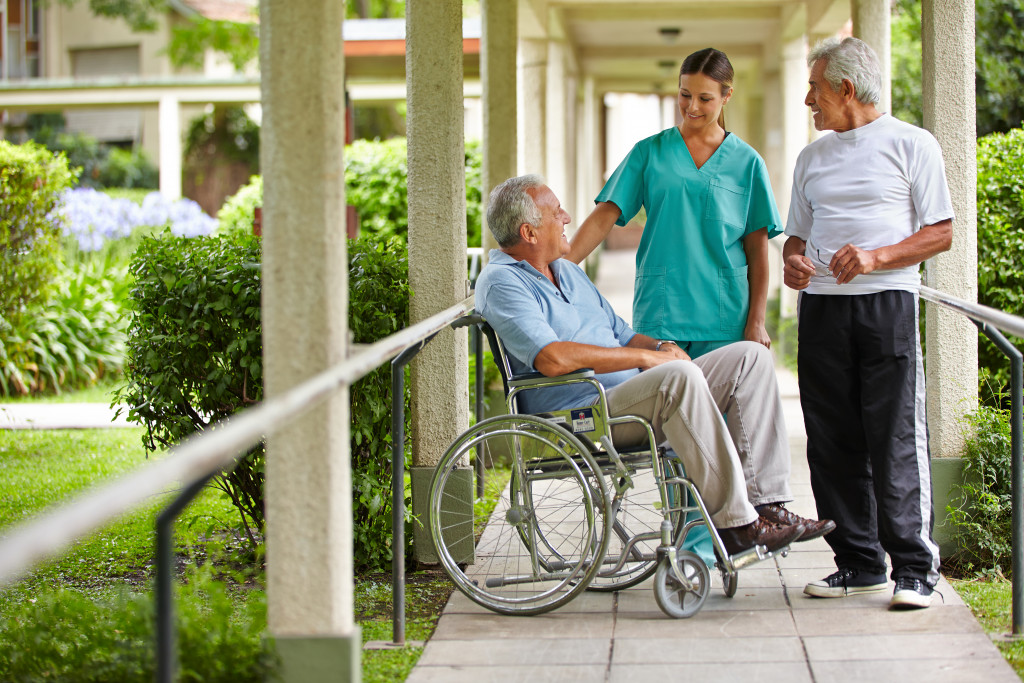- Common mobility issues in elderly people include arthritis, vision impairment, muscle weakness, and neurological conditions.
- Professional help should be sought to diagnose the issue and develop a plan of action to address it.
- Low-impact exercises like swimming, yoga, and Pilates promote mobility and maintain strength and flexibility.
- Assistive devices like canes, walkers, and wheelchairs can help with mobility, and financial assistance programs are often available.
As people age, their mobility can be affected by various factors. It’s not uncommon for elderly people to experience difficulties with walking, standing, and other types of movement. In fact, according to research from the National Institute on Aging, more than one-third of individuals over the age of sixty-five experience some kind of mobility issue. Fortunately, there are several things seniors and their families can do to help them stay active and mobile as they get older.
Common Mobility Issues
Depending on the individual’s medical history and personal lifestyle, mobility issues can arise in elderly people. Some of the most common problems include:
Arthritis:
This condition is characterized by joint pain and inflammation, making it difficult to move. As people age, arthritis becomes more common, leading to problems with balance and movement.
Although this condition cannot be cured, medications, physical therapy, and other treatments can help relieve symptoms.
Vision Impairment:
Poor vision can cause difficulty with navigation or impair the ability to recognize obstacles on the ground, making mobility more difficult. This is usually caused by age-related conditions such as glaucoma or cataracts. Regular eye exams and wearing glasses or contact lenses can help improve vision and make it easier to move around. Special treatments are also available to help people with more severe vision impairments.
Muscle Weakness:
With age comes a natural weakening of the muscles and joints. This leads to difficulty with walking, standing, and other movements. Conditions like diabetes and heart disease can also cause muscle weakness. For elderly people, strength training and being active are necessary to keep the muscles strong and maintain mobility.
Neurological Conditions:
Diseases like Parkinson’s or Multiple Sclerosis can cause significant movement problems. Also, strokes can cause temporary or permanent mobility issues. Most of these conditions don’t have a cure, but medications and physical therapy can help improve mobility.

Seek Professional Help
If you or a loved one are experiencing any mobility issues, it’s important to seek professional help. These professionals can help diagnose the specific problem and develop a plan of action to address it. Below are some examples of services to consider:
Specialized Doctor:
Consult a doctor specializing in elderly health care and can help diagnose mobility issues. They may recommend medications, physical therapy, or other treatments to help improve mobility. Remember to maintain regular check-ups with a doctor to ensure that the mobility problems are being addressed. After all, maintaining good health is essential for mobility.
Occupational Therapist:
These professionals specialize in helping people rebuild lost skills and activities of daily living. They will work with you to assess your needs and develop an individualized plan to improve your mobility. For example, they can recommend different exercises or devices to help balance and coordination.
Residential Care Homes:
It can be overwhelming to manage an elderly person’s mobility needs at home. Therefore, consider looking for cozy residential care homes to help them stay safe in a comfortable environment. These homes have a team of professionals specializing in elderly care and can help with mobility issues. Your loved one also won’t have to worry about home maintenance and other household responsibilities.
Exercise Is Key
The importance of exercise cannot be overstated when promoting mobility in the elderly. Moreover, regular exercise helps promote healthy circulation throughout the body, which is essential for the proper function of muscles and joints.
Low-impact exercises like swimming, yoga, and Pilates can help seniors maintain strength and flexibility while also focusing on balance. There are also senior centers that offer group classes so they can socialize and stay active at the same time.
In addition to physical activities, mental exercises help improve balance and coordination in seniors. Puzzles, games, and activities like tai chi or qigong are all great ways to stimulate the mind while improving overall mobility.

Use Assistive Devices
If you’re experiencing difficulty walking or standing up from sitting, using assistive devices can significantly improve your quality of life.
Canes and walkers are two standard tools that provide extra stability when walking or standing up from sitting positions. There are even wheelchairs available for those who need more assistance to remain mobile throughout their day-to-day activities.
Additionally, many communities have programs that offer special discounts on assistive devices for those who qualify financially. There are also organizations like the Arthritis Foundation that provide grants and other resources to help senior citizens remain active and independent.
Mobility issues can be a significant problem for elderly people, but there are solutions. With the right medical help and assistive devices, seniors can stay active and independent as they age. Exercise is also crucial in helping to maintain strength and flexibility while improving balance and coordination. Ultimately, it’s important to remember that mobility is integral to life at any age. Therefore, it is necessary to take proactive measures now to ensure that you or your loved one stays healthy well into old age.





